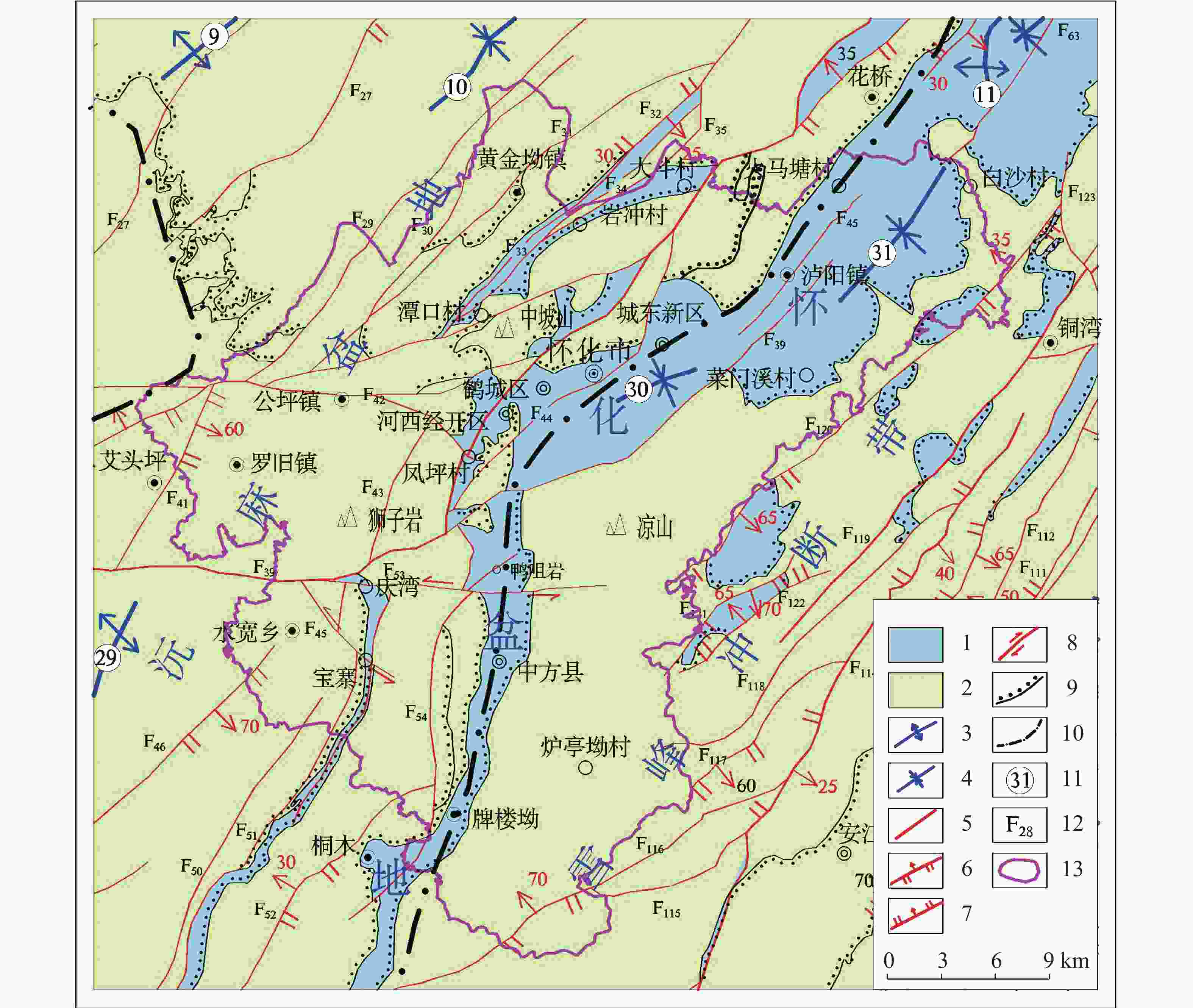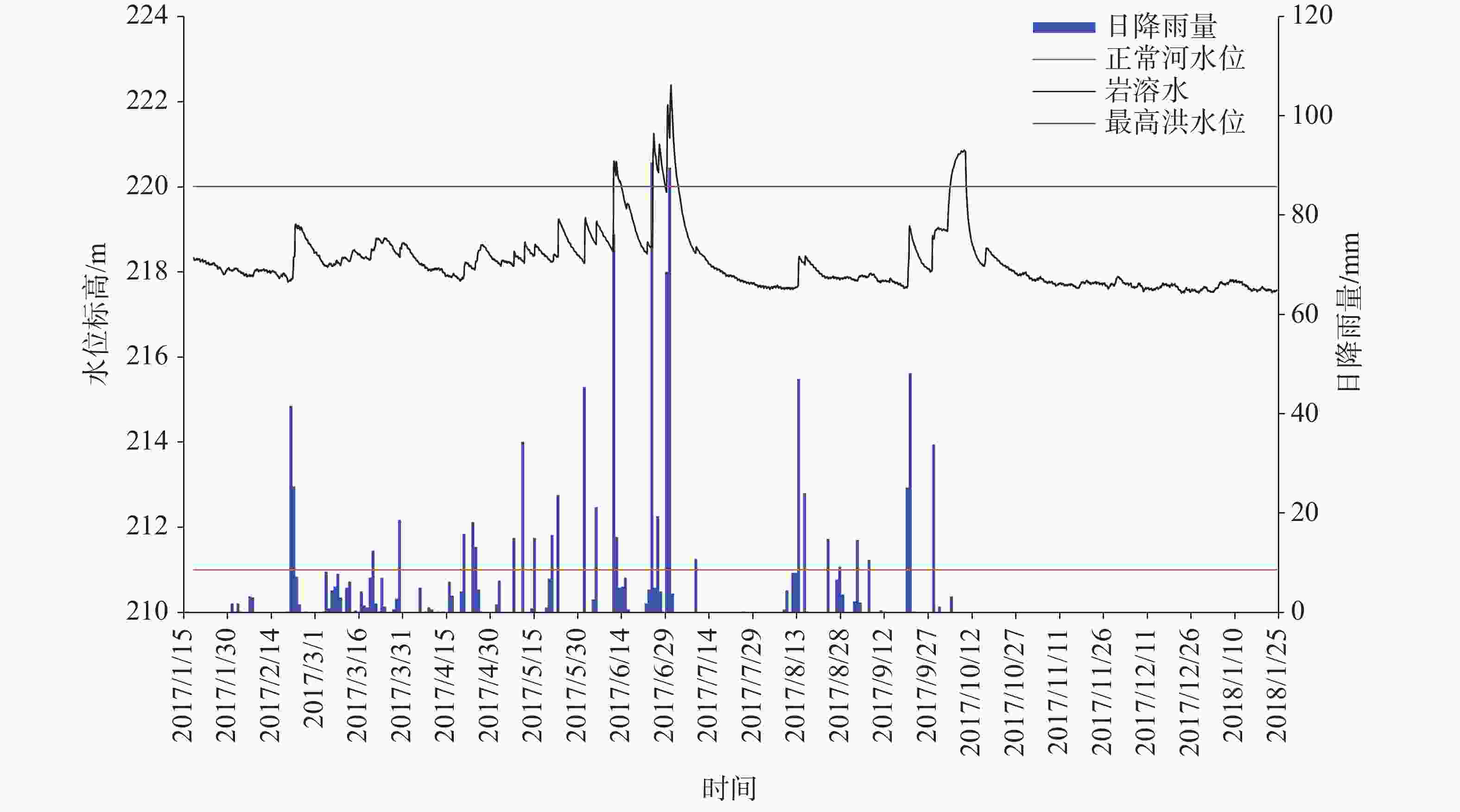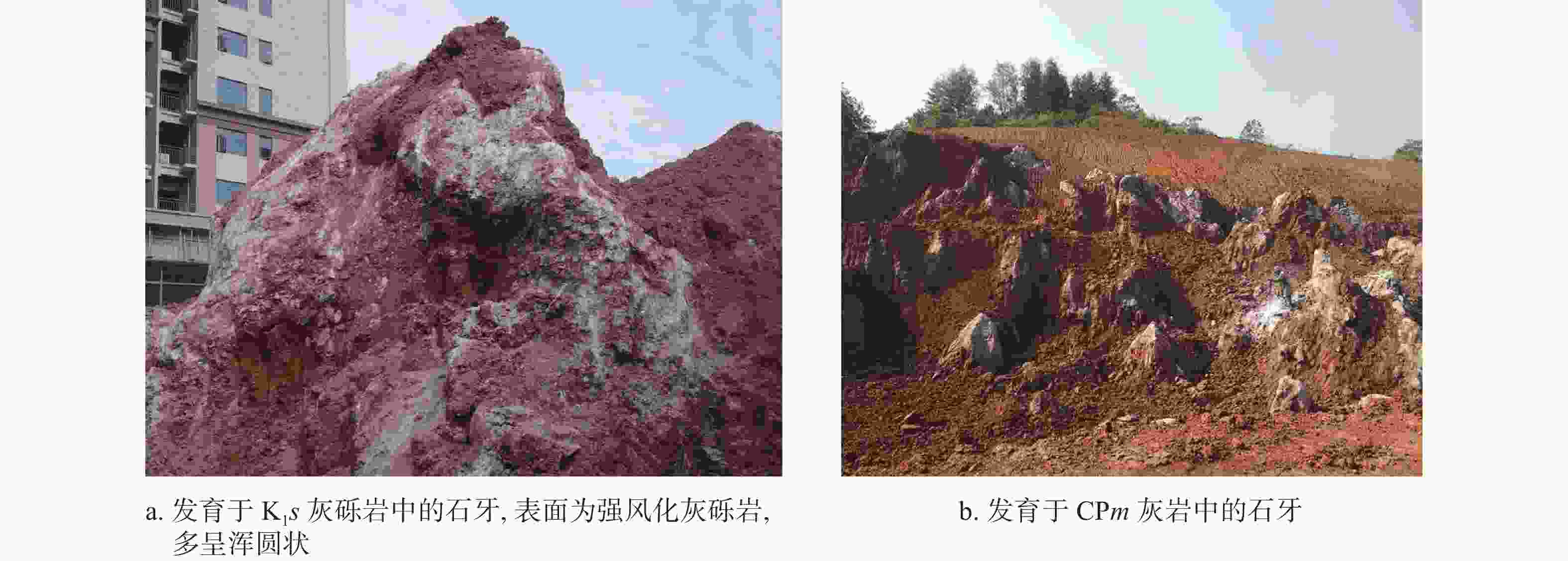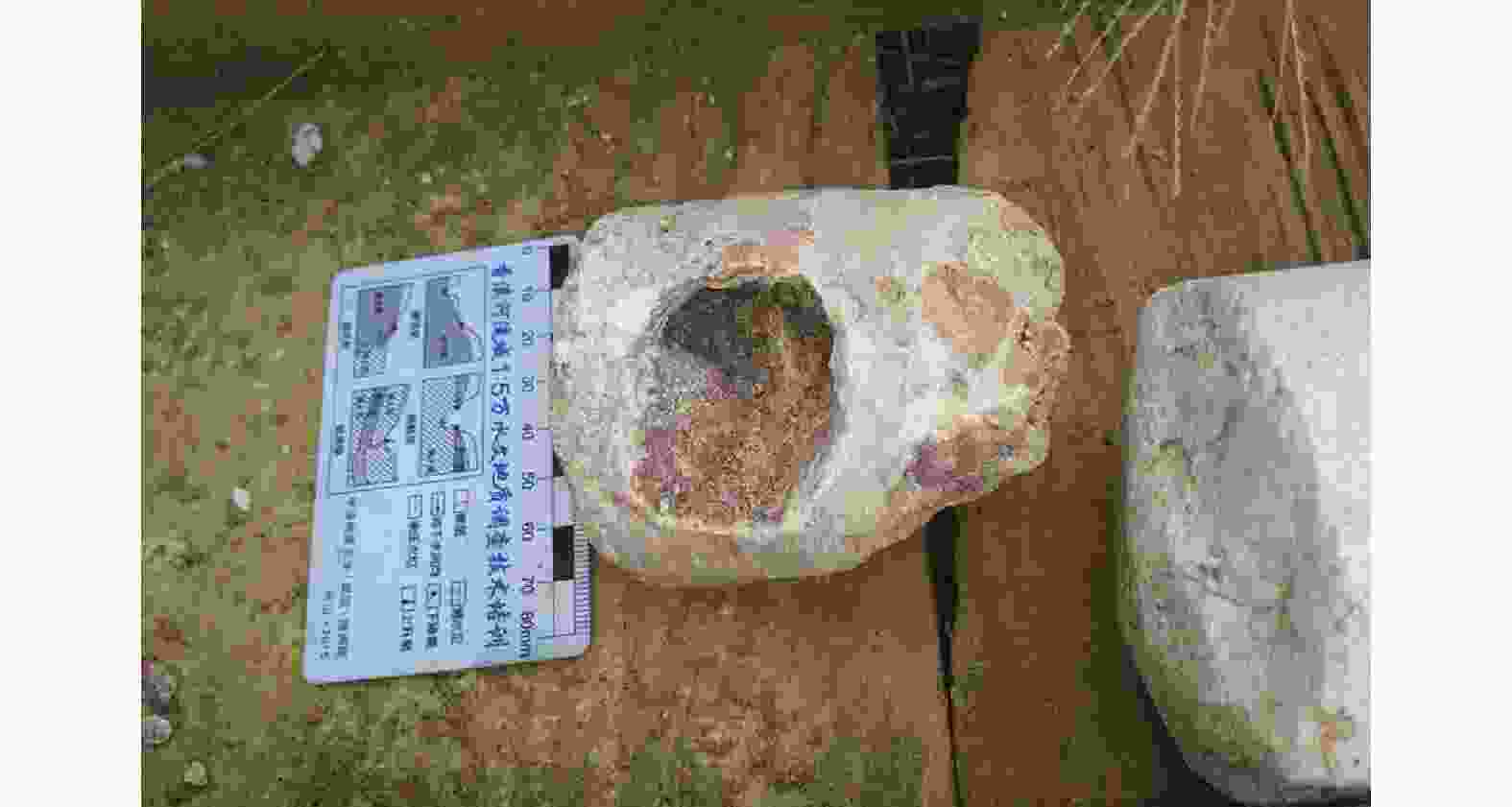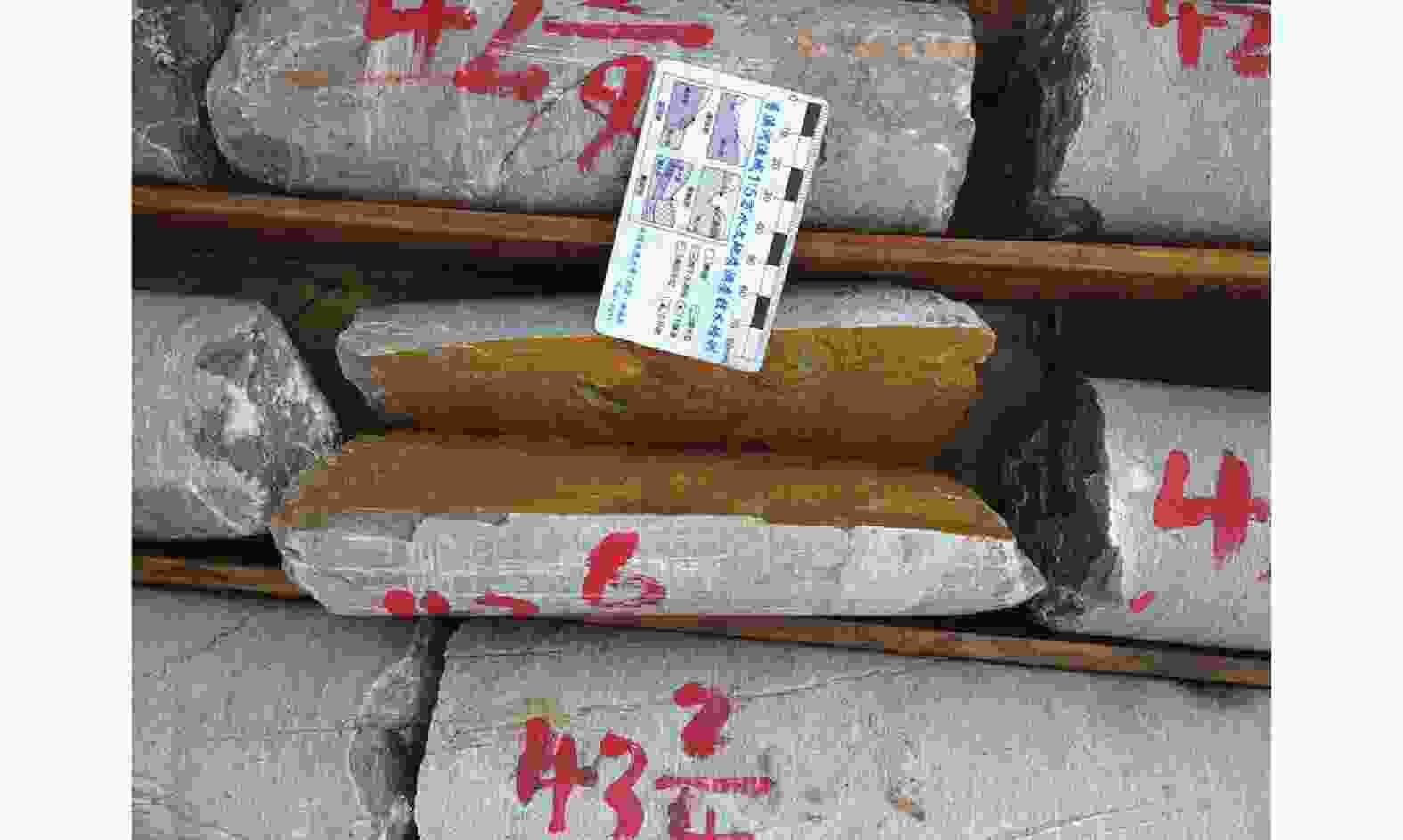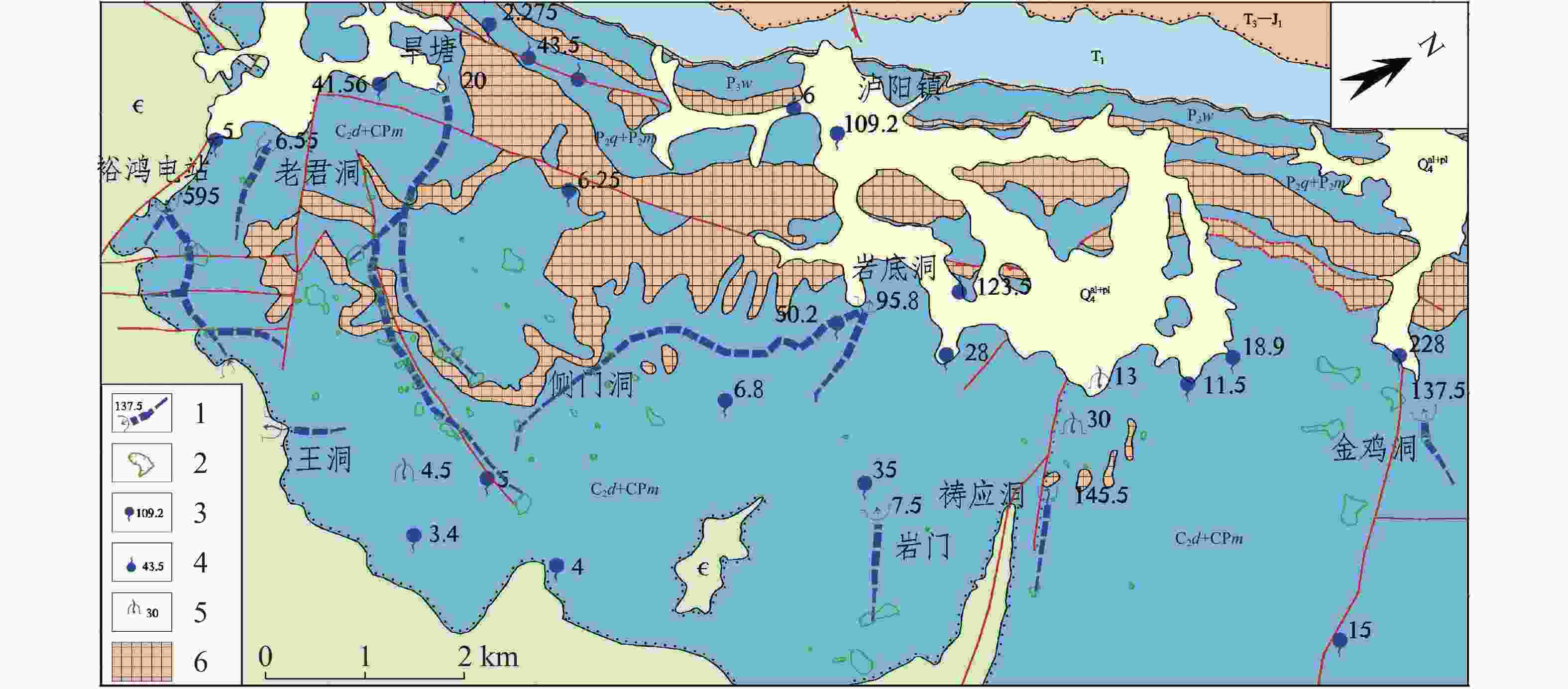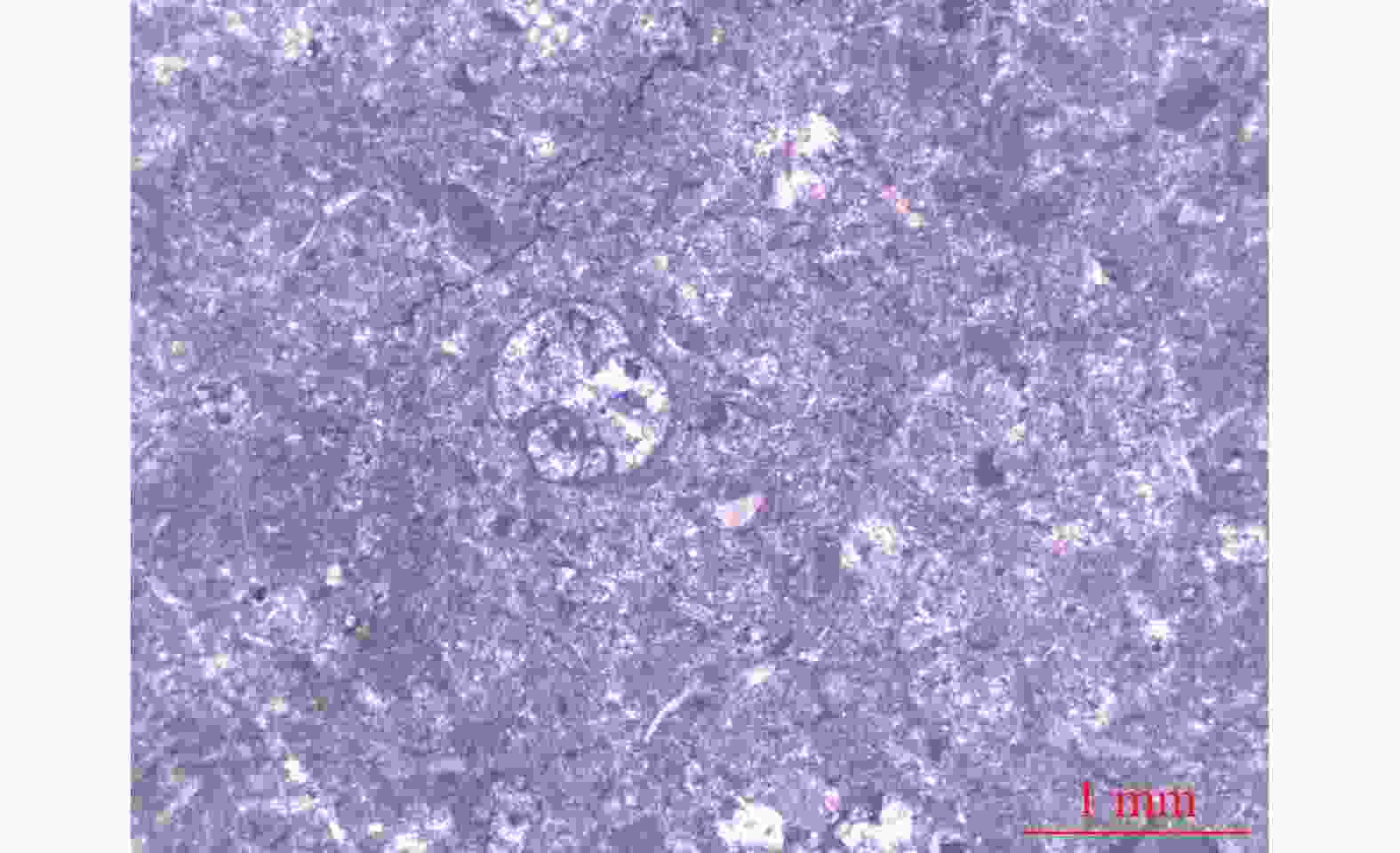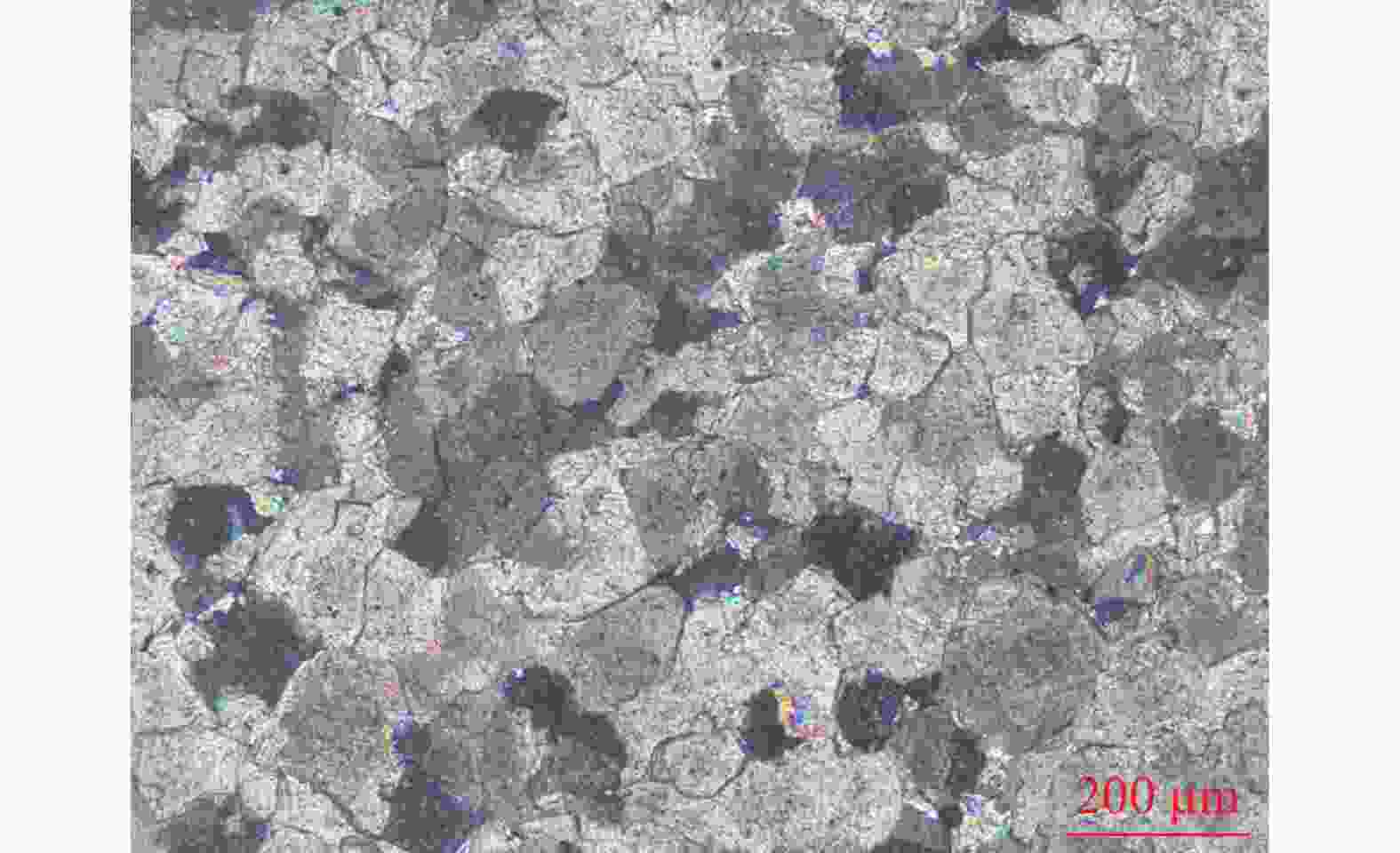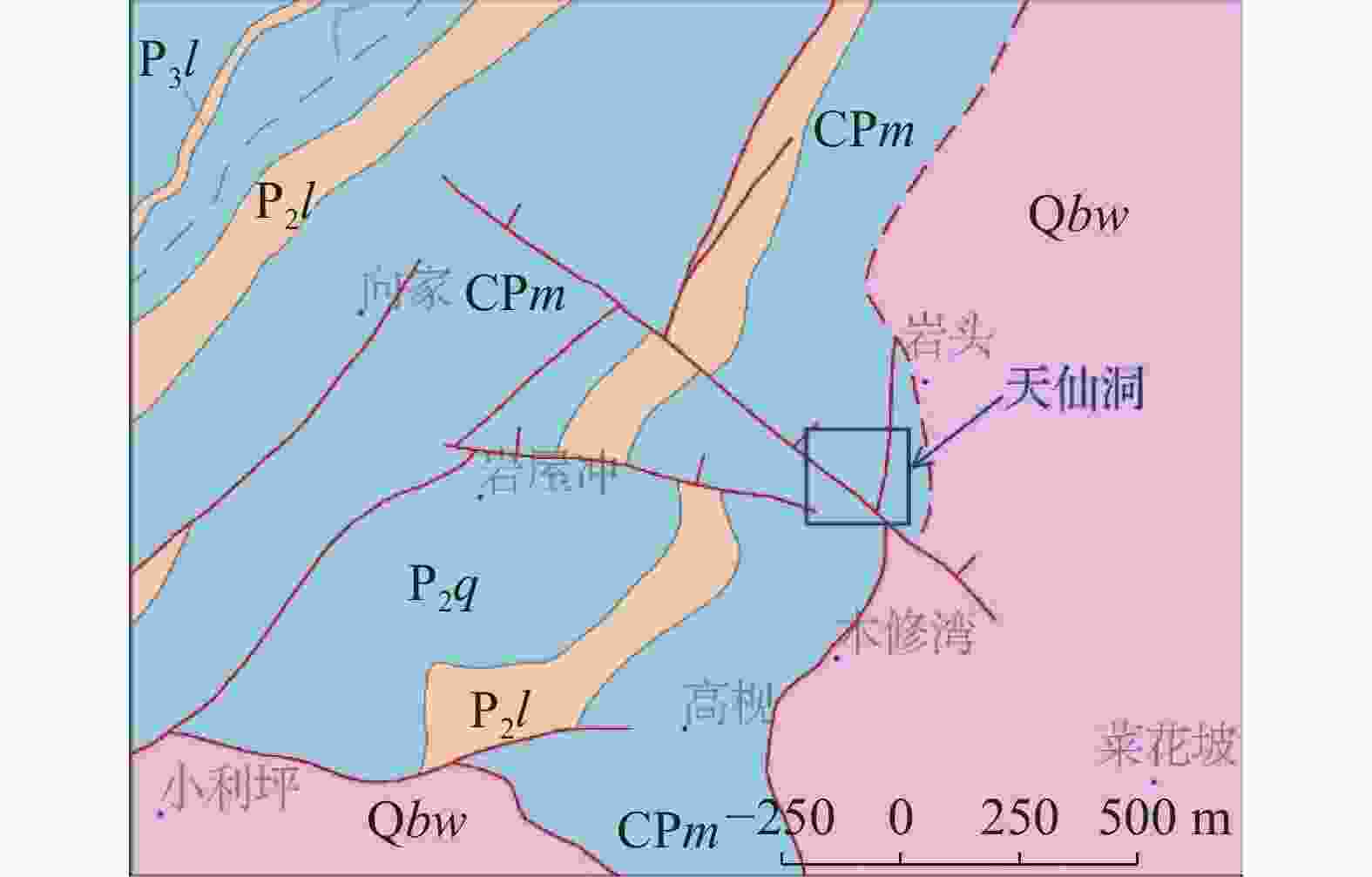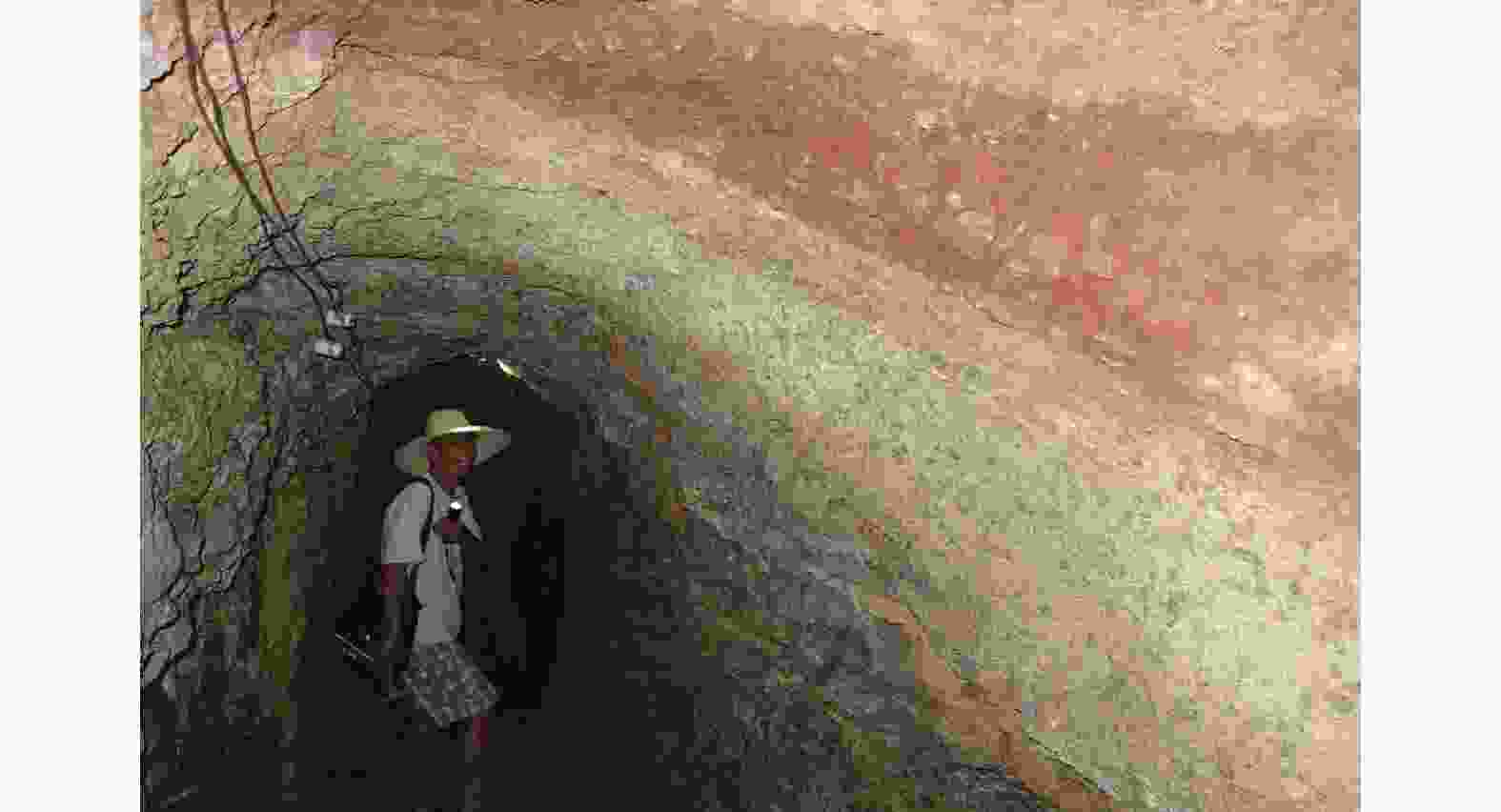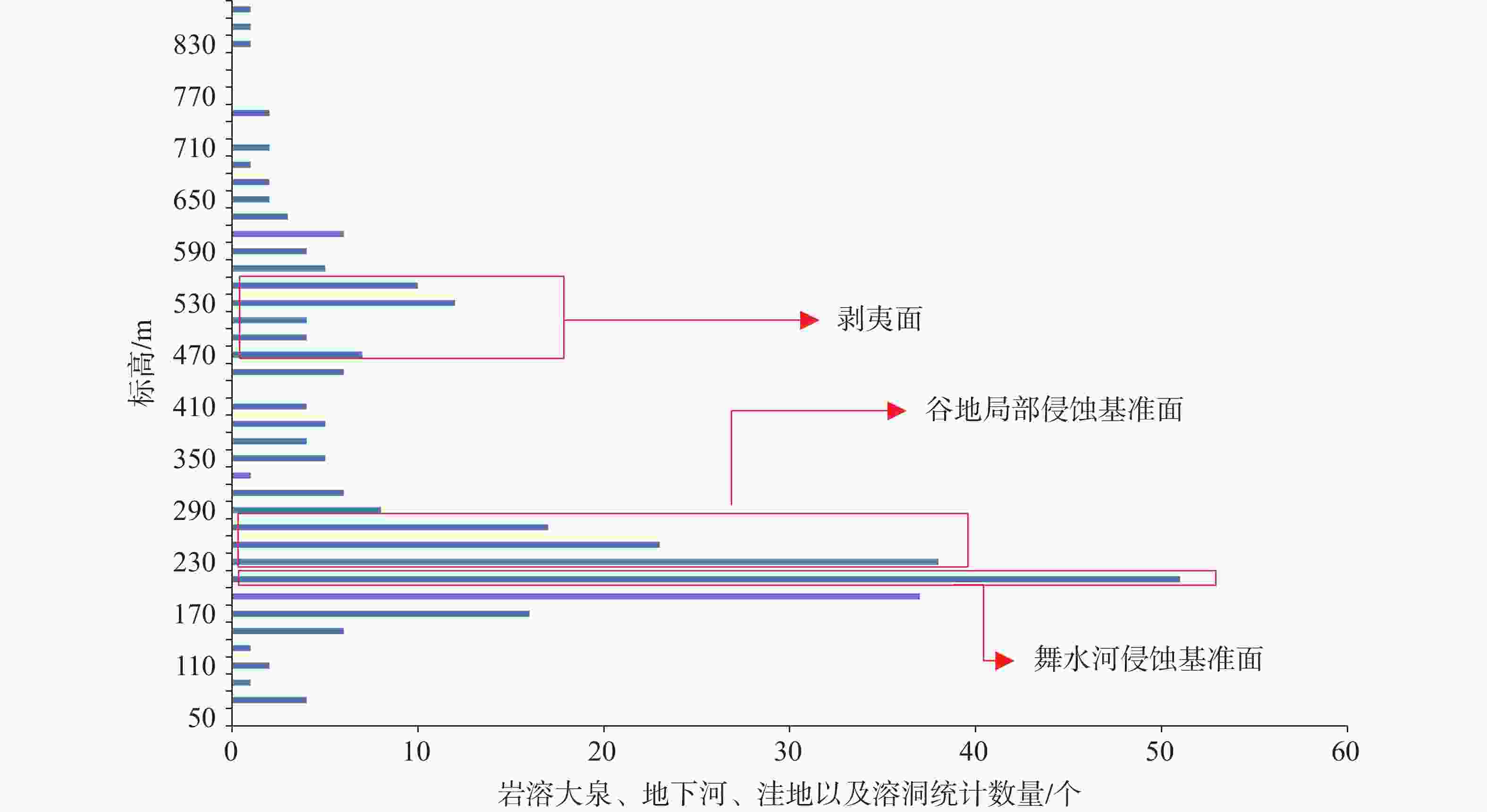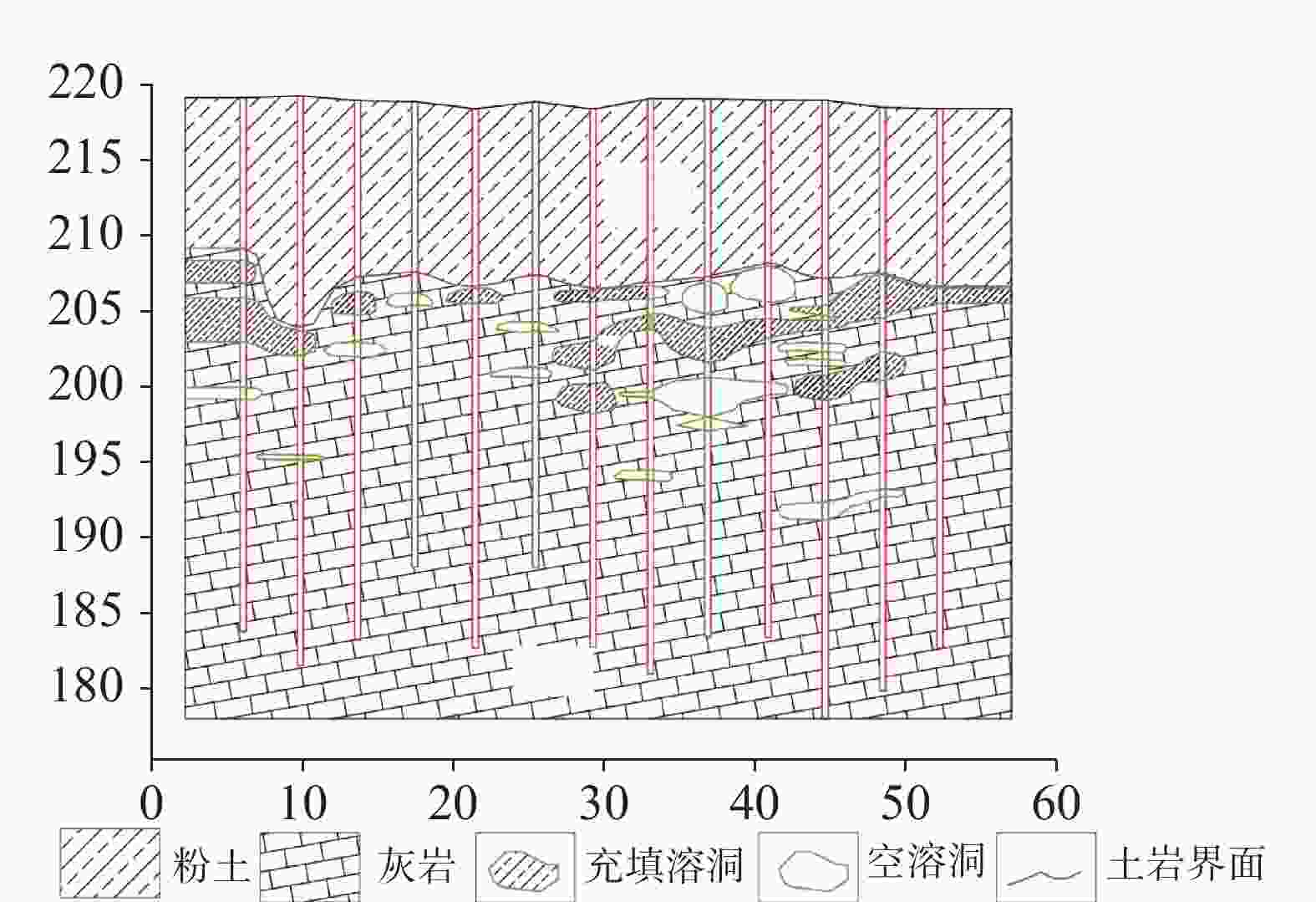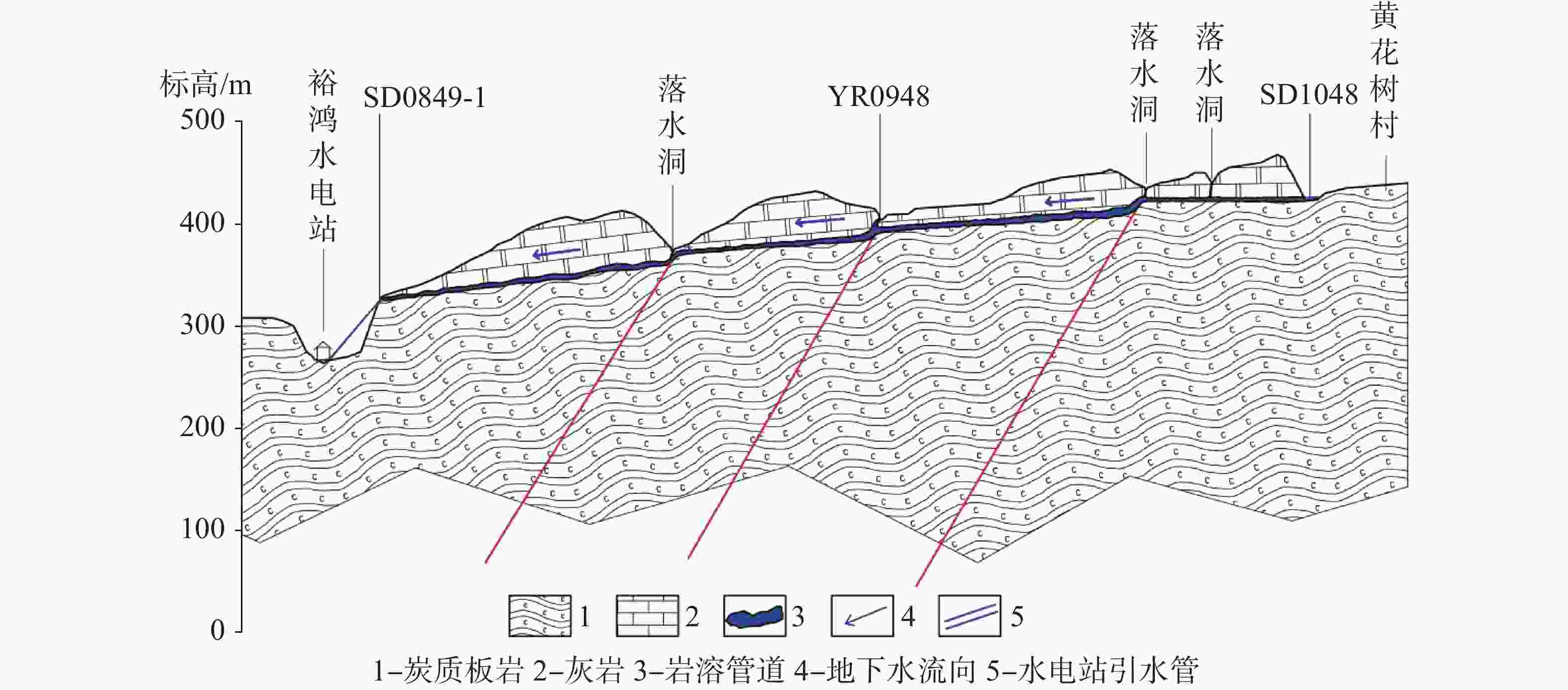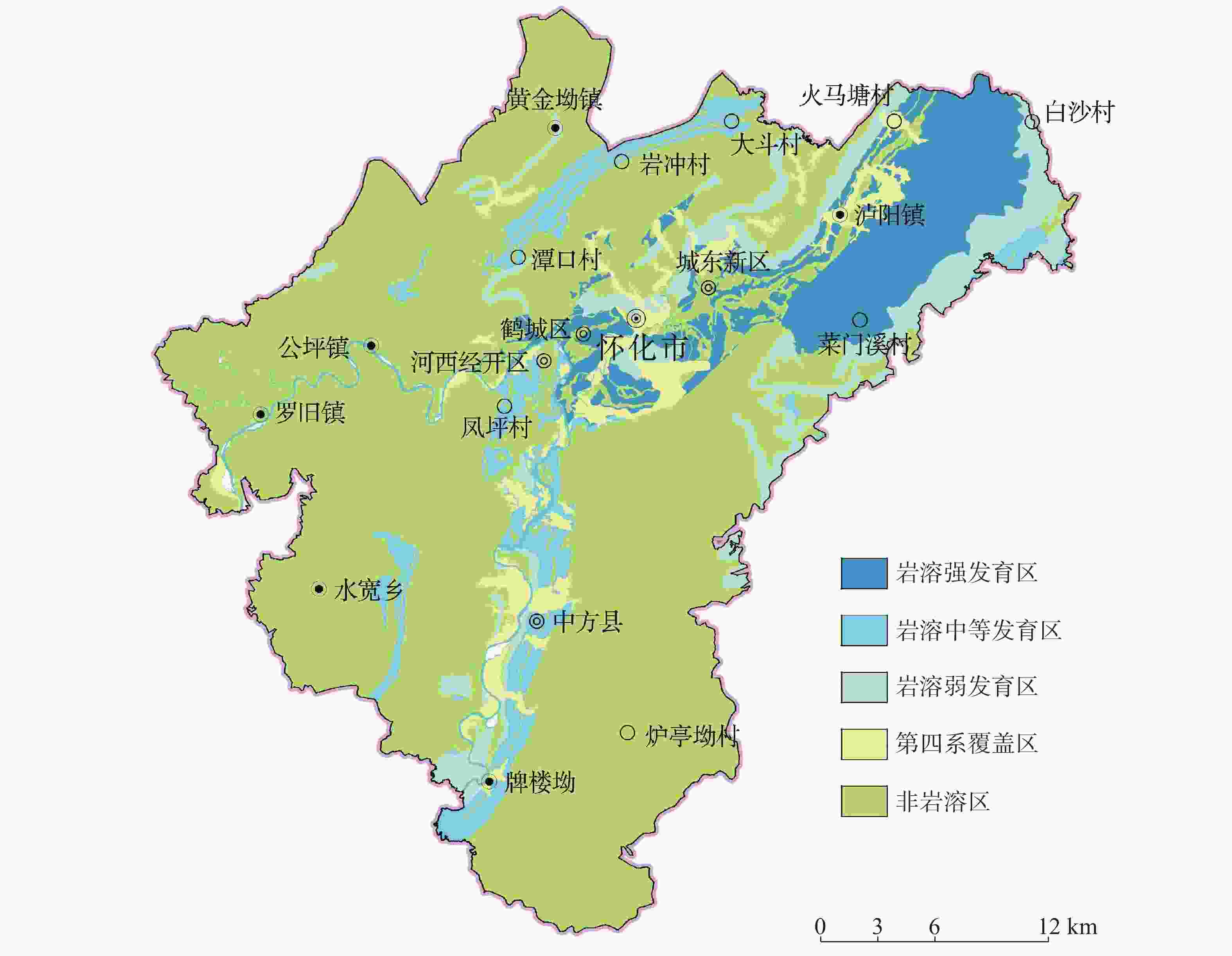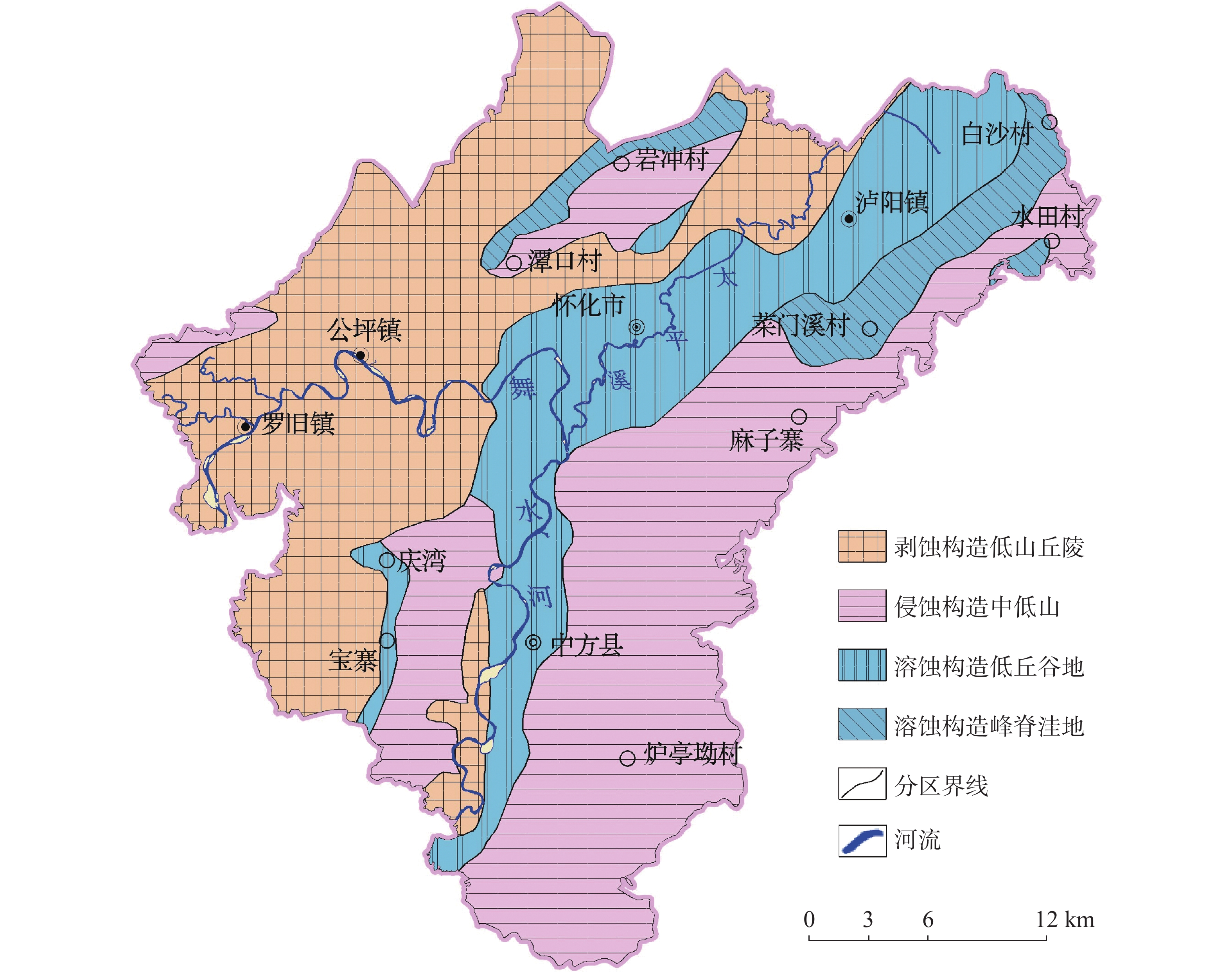Karst development characteristics and distribution law in Huaihua basin, Hunan Province
-
摘要: 怀化盆地位于沅麻盆地和雪峰山冲断带2个构造单元接触带上,区内地质构造条件复杂,岩溶强烈发育。文章以区内碳酸盐岩为研究对象,通过资料收集、野外调查、钻探以及测试等工作手段分析空间上的地层、岩性组合特征,从岩溶形态、地层与岩性、构造条件、侵蚀基准面、地貌与水动力条件、可溶岩与非可溶岩接触带六个方面,系统总结怀化盆地岩溶发育特征。结果发现:研究区以覆盖型岩溶区为主,区内各类岩溶形态发育;区内自高向低存在三个溶蚀最发育段,其标高分别为500~600 m、210~270 m以及190~210 m,分别受历史侵蚀基准面、泸阳-怀化-中方谷地局部侵蚀基准面与舞水河侵蚀基准面控制;区内各地层钻孔遇洞率一般为57.1%~61.5%,最高为87.5%;谷地内各地层岩溶发育强度依次为厚层灰岩>白云岩>红层灰砾岩>薄层灰岩,但受地貌、水动力条件影响,溶蚀构造峰脊洼区的白云岩岩溶发育明显较谷地内更为强烈;舞水河沿岸、断层带附近、可溶岩与非可溶岩接触带以及山前冲洪积区等地下水交替循环强烈的地带,岩溶发育相对更为剧烈;区内岩溶强发育区主要分布于泸阳-城东新区、白沙-菜门溪一带。Abstract:
Huaihua basin is located at the center of the marginal areas of Hunan, Hubei, Chongqing, Guizhou and Guangxi. Shanghai-Kunming high-speed railway, Zhangjiajie-Jishou-Huaihua high-speed railway, Huaihua-Guilin high-speed railway (under planning), Chongqing-Huaihua high-speed railway and Huaihua-Shaoyang-Hengyang high-speed railway converge in Huaihua basin in the shape of Chinese character "mi", which makes Huaihua City a new national comprehensive transportation hub. Located in the zone of temperate subtropical monsoon climate, the study area is humid with abundant rainfall. The average rainfall over the year is 1,326.3 mm, with the maximum of 1,663 mm. Rainfall is mainly concentrated in April to August, accounting for more than 70% of the average annual precipitation. The landforms of the study area are mainly middle and low mountains and karst valleys. In the west is Zhongpo mountain-Shiziyan mountain range, and in the east is Liangshan mountain range. The overall topography is high in the northwest and southeast, and low in the middle, showing a basin form spreading in the NNE to NNE. The pure carbonate strata in the study area from old to new sequence are middle Dapu formation of Carboniferous (C2d), upper Maping formation (CPm), middle Qixia formation of Permian (P2q), Maokou formation (P2m), upper Wujiaping formation (P3w), second section of lower Daye formation of Triassic (T1d2), and lower Shimen formation of Cretaceous (K1s). The regional structure in the area belongs to the Neocathaysian tectonic system, which is located in the contact zone of thrust-fold belt between the Yuanma basin and the Xuefengshan. The main structure in the area is the north (north) east compressive structure, and the others are associated structures. The geological structure of Huaihua basin is very complex and karst is strongly developed. However, the previous studies mainly focus on the basic introduction of karst development characteristics in a small area. In addition, the 1∶50,000 regional geological-and-hydrogeological survey has not yet covered the study area. Therefore, the geological research in this area is generally not profound, and the existing geological data is difficult to meet the needs of urban planning and construction. Taking carbonate rocks in the area as the research object, a large number of previous geological data has been collected and analyzed. New geological investigation and drilling have been used to explore the space characteristics of strata and lithology combination. The characteristics of karst development in Huaihua basin have been systematically summarized from six aspects, namely, karst morphology, strata and lithology, tectonic conditions, base level of erosion, landform and hydrodynamic conditions, the contact zones of soluble and non-soluble rocks. Furthermore, Huaihua basin has been zoned according to the development degree of karst. The research findings show as follows, (1) The spatial distribution of soluble rocks in the study area is not uniform, mainly in covering karst areas and partially in buried-karst areas. Solution grooves, stone teeth and sinkholes are developed in the whole area, while the underground river is mainly developed in the tectonically dissolved peak ridge depression in the Baisha-Caimenxi area in the eastern part of the study area. (2) Karst development in the area is mainly controlled by the stratigraphic group, and the next controlling factor is lithology. The karst development intensity of each layer in the valley is ranked as thick-layer limestone (CPm, P2m, P2q, P3w)>dolomite (C2d)>red-bed gray conglomerate (K1s )>thin-layer limestone (T1d 2). However, influenced by geomorphology and hydrodynamic conditions, the karst development of dolomite (C2d ) in tectonically dissolved peak ridge depression is more intense than that in valley. (3) From high to low, there are three most developed segments of dissolution in the study area, with elevations of 500-600 m, 210-270 m and 190-210 m respectively. These three segments are respectively controlled by base level of historical erosion, base level of partial erosion in Luyang-Huaihua-Zhongfang valley and base level of partial erosion of Wushui river. Among them, the main karst forms in the segments at the depth of 210-270 m and of 190-210 m are karst springs, underground rivers, dissolved pores, solution cracks and caves under the overburden of valley. (4) The karst development is more intense in areas with strong alternating groundwater circulation, such as the banks of Wushui river, the fault zone, the contact zone between soluble and non-soluble rocks, and the piedmont alluvial area. The karst area is mainly distributed in Luyang-Chengdong new area and Baisha-Caimenxi area in the southeast of Luyang valley. If engineering activities such as groundwater exploitation, drainage of foundation pit, pile foundation construction, tunnel construction, etc. are planned to carry out in these areas, special risk assessment of geological disasters caused by karst collapse in construction site is needed. -
表 1 岩溶层组类型划分
Table 1. Classification of karst strata group
岩溶层组类型 碳酸盐岩占比/% 地层 主要岩性 连续
厚度分布地区 均匀状纯碳酸
盐岩岩组灰岩
层组>90 CPm、P2q、P2m、
P3w、T1d2灰色中厚层状、
薄层状微晶灰岩>200 m 泸阳-怀化-中方、岩冲-潭口、庆湾-宝寨、公坪水泥厂一带 白云岩层组 C2d、T1d3 浅灰色、肉红色厚层块状白云岩 >200 m 泸阳-怀化-中方一带的谷地东侧 不纯碳酸
盐层组均匀状或间层状不纯碳酸盐岩层组 40~60 ∈3-4t 灰岩夹炭质板岩、灰岩夹炭质页岩 >200 m 麻子寨-水田 碎屑岩夹碳酸盐岩层组 <40 Z1j、Z2l、
∈2-3w硅质岩、硅质泥岩夹灰岩、泥灰岩 <200 m 麻子寨-水田 红层灰砾岩 \ K1s 灰砾岩 <100 m 沿泸阳-怀化-中方谷地北西侧边缘分布 表 2 研究区主要碳酸盐岩地层溶洞发育情况
Table 2. Statistical table of the development of underground karst cave in carbonate rock strata
地层 溶洞个数 溶洞高度统计/个 溶洞充填情况/个 <1 m 1~3 m 3~5 m 5~10 m >10 m 无充填 半充填 全充填 C2d 15 7 6 0 2 0 9 1 5 CPm 34 10 19 1 4 0 21 / 13 P2m 58 20 25 5 8 0 33 22 3 P2q 12 5 4 0 3 0 4 4 4 P3w 44 15 19 6 3 1 7 28 9 T1d2 0 / / / / / / / / K1s 4 0 3 1 0 0 3 1 0 表 3 研究区地下河一览表
Table 3. List of underground rivers in the study area
序号 野外编号 名称 洞口高程/m 发育层位 洞长/m 流量/L·s−1 水力坡度 总体走向 洞口位置控制因素 1 SD1659 金鸡洞 269 C2d 270 137.5 1.226 NW 侵蚀基准面控制 2 SD0849-1 裕鸿电站 325 C2d 2160 595.0 0.053 NW-NE 层面控制 3 SD1454-2 岩门洞地下河 524 C2d 1125 7.5 0.192 NW 侵蚀基准面控制 4 SD1254-1 岩底洞 264 CPm 4250 95.8 0.093 NE 侵蚀基准面控制 5 SD1555 祷应洞 435 CPm 900 145.5 0.183 NW 层面控制 6 SD0952-1 旱塘地下河 239 CPm 4840 20.0 0.087 NW 侵蚀基准面控制 7 SD0850 老君洞 262 C2d 1120 6.6 0.230 NW 侵蚀基准面控制 8 YR1149 王洞 492 C2d 600 1.0 0.038 EW 层面控制 9 1-SD054 凤坪地下河 211 P2q 540 55.7 0.035 NW 侵蚀基准面控制 10 SD9343-1 青子坪地下河 235 CPm 830 1.5 0.102 NW-NE 侵蚀基准面控制 表 4 研究区主要碳酸盐岩地层岩石化学成分与岩溶发育情况
Table 4. Chemical composition of rock and karst development in the study area
地层层位 岩性特征 地层连续
厚度/m地层单层
厚度/cm平均化学成分/% 钻孔遇洞
率/%线岩溶率/% 塌陷数量
/个CaO MgO CaO/MgO 平均 最大 最小 C2d 厚层块状白云岩、灰质白云岩 116~605 50~100 33.21 18.63 1.8 40.0(15) 10.7 23.8 1.7 34 CPm 厚层块状(生物碎屑)灰岩 150~410 50~100 52.40 0.33 158.8 57.1(28) 9.3 42.9 0.6 27 P2m 厚层块状(生物碎屑)灰岩 100~316 50~100 51.60 0.26 198.5 61.5(26) 22.8 58.7 0.7 20 P2q 厚层块状(生物碎屑)灰岩 38~66 50~100 54.17 0.39 138.9 60.0(10) 13.6 56.7 1.7 25 P3w 厚层块状含硅质条带(团块)灰岩 270 50~100 51.70 0.35 147.7 87.5(16) 8.7 24.1 0.4 0 T1d2 薄层片状灰岩、泥灰岩,
夹页岩或泥质条带226 1~10 52.23 0.26 200.9 0.0(3) / / / 2 K1s 厚层块状灰质砾岩 20.0~91.3 50~100 / / / 66.7(3) 6.6 8.5 4.7 2 注:白沙—菜门溪村一带的高位溶蚀构造峰脊洼地(C2d)内发育29个岩溶塌陷;化学成分数据来源于文献[24]、[25];表中括号内数字为钻孔统计样本个数。 表 5 岩溶发育分区及特征描述
Table 5. Karst development zoning and characteristic description
分区 分布范围 面积/km2 地层代号 岩溶发育特征 水文地质指标 强 泸阳—西牛
泉一带52.83 CPm、P2q、
P2m、P3w主要为覆盖型岩溶,水量丰富;岩溶水点密度平均0.73个·km−2,塌陷密度平均0.82个·km−2;区内有23个钻孔,14孔遇洞39个,遇洞率60.9%;最大单孔线岩溶率57.0%,平均线岩溶率13.9% 区内有49处泉点,流量一般为11.5~41.6 L·s−1,最大流量为228.0 L·s−1(SD1159),总流量为1 164.7 L·s−1;区内机民井10处,开采强度较小,装泵量一般为5~10 m3·h−1;本次收集及施工的25处水文地质钻孔资料,14孔单井涌水量>1 000 m3·d−1,占总数的56.0% 中 怀化城区—高铁
南站一带15.32 CPm、P2q、
P2m、P3w主要为覆盖型岩溶,水量丰富;岩溶水点密度平均0.46个·km−2(由于城区发展,大多数水点已消失),塌陷密度平均0.20个·km−2;区内有11个钻孔,5孔遇洞15个,遇洞率45.5%。最大单孔线岩溶率42.1%,平均线岩溶率3.8% 区内有16处泉点,流量一般为1.0~4.0 L·s−1,最大流量为15.4 L·s−1(1-SD067),总流量为65.3 L·s−1;区内机民井6处,民井开采强度较小,机井装泵量一般为10~25 m3·h−1;本次收集及施工的23处水文地质钻孔资料,4孔单井涌水量>1 000 m3·d−1,占总数的17.4% 弱 金鸡洞—菜门
溪村一带53.02 C2d 主要为裸露型岩溶,水量丰富;岩溶水点密度平均0.55个·km−2,塌陷密度平均0.55个·km−2;区内有4个钻孔,1孔遇洞1个,遇洞率25.0%,单孔线岩溶率1.4% 区内有19处泉点,6条地下河,泉点流量一般为2.6~5.0L·s−1,最大流量为6.8 L·s−1(SD1353),地下河流量最大为595.0 L·s−1(裕鸿水电站),总流量为906.0 L·s−1;区内主要引用泉点岩溶水,未调查到机民井 -
[1] 马慧. 湖南省怀化市地质灾害区划与防治规划研究[D]. 长沙: 中南大学, 2009.MA Hui. Study on geological hazard zoning and prevention planning in Huaihua City, Hunan Province[D]. Changsha: Central South University, 2009. [2] 柏道远, 姜文, 钟响, 熊雄. 湘西沅麻盆地中新生代构造变形特征及区域地质背景[J]. 中国地质, 2015, 42(6):1851-1875.BAI Daoyuan, JIANG Wen, ZHONG Xiang, XIONG Xiong. Mesozoic-Cenozoic structural deformation characteristics of Yuanling-Mayang basin and regional tectonic setting[J]. Geology in China, 2015, 42(6):1851-1875. [3] 李国亮, 刘耀荣, 柏道远, 王先辉, 何江南, 凌跃新, 杨俊. 湖南1∶25万怀化幅区域地质调查主要成果及新认识[J]. 中国地质调查, 2016, 3(3):38-46.LI Guoliang, LIU Yaorong, BAI Daoyuan, WANG Xianhui, HE Jiangnan, LING Yuexin, YANG Jun. New understanding and achievements in regional geological survey of 1:250,000 Huaihua sheet, Hunan Province[J]. Geological Survey of China, 2016, 3(3):38-46. [4] 雷旭友, 程凯. 电磁波CT在重庆至怀化铁路岩溶塌陷病害抢险勘探中的应用[J]. 工程地球物理学报, 2009, 6(5):561-565. doi: 10.3969/j.issn.1672-7940.2009.05.006LEI Xuyou, CHENG Kai. The application of electromagnetic wave CT method in exploration of dealing with emergency in the K419 karst collapse hazard on Chongqing-Huaihua railway line[J]. Journal of Engineering Geophysics, 2009, 6(5):561-565. doi: 10.3969/j.issn.1672-7940.2009.05.006 [5] 周笑, 林春洪. 沪昆客运专线怀化某段的工程地质问题分析[J]. 土工基础, 2012, 26(5):72-74. doi: 10.3969/j.issn.1004-3152.2012.05.025ZHOU Xiao, LIN Chunhong. Some engineering geology problems in Huaihua section of Shanghai-Kunming passenger rail[J]. Geotechnical Foundation, 2012, 26(5):72-74. doi: 10.3969/j.issn.1004-3152.2012.05.025 [6] 孟庆文, 徐永明. 铁路客运专线岩溶发育区工程地质选线[Z]. 2012.3.MENG Qingwen, XU Yongming. Engineering-geological route selection of passenger dedicated railway in karst development area[Z]. 2012.3. [7] 林春洪, 张海鹏, 李文谦, 姚建强. 管波探测法在沪昆客运专线怀化段桩基岩溶勘探中的应用[J]. 福建建筑, 2013(8):60-62.LIN Chunhong, ZHANG Haipeng, LI Wenqian, YAO Jianqiang. Tube wave detecting method on the Shanghai-Kunming passenger line pile of bedrock in Huaihua in karst exploration[J]. Fujian Architecture, 2013(8):60-62. [8] 邬健强, 赵茹玥, 甘伏平, 张伟,刘永亮,朱超强. 综合电法在岩溶山区地下水勘探中的应用: 以湖南怀化长塘村为例[J]. 物探与化探, 2020, 44(1):93-98.WU Jianqiang, ZHAO Ruyue, GAN Fuping, ZHANG Wei, LIU Yongliang, ZHU Chaoqiang. The application of electrical prospecting method to groundwater exploration in karst mountainous areas: A case studly of Changtang village, Huaihua area, Hunan Province[J]. Ceoplhysical and Geochemical Exploration, 2020, 44(1):93-98. [9] 湖南省革命委员会地质局区测队. 1∶20万区域地质调查报告(芷江幅)[R]. 湖南怀化, 1973.Survey Team of Geological Bureau of Hunan Revolutionary Committee. 1∶200,000 Regional Geological Survey Report (Zhijiang) [R]. Huaihua, Hunan, 1973. [10] 中国人民解放军部队七三零部队. 1∶20万区域水文地质普查报告(芷江幅)[R]. 湖南怀化, 1975.Chinese People's Liberation Army 730 Unit. 1∶200,000 Regional Hydrogeological Survey Report (Zhijiang) [R]. Huaihua, Hunan, 1975. [11] 湖南省地质调查院. 1∶25万区域地质调查报告(怀化幅)[R]. 湖南长沙, 2014.Hunan Geological Survey Institute. 1∶250, 000 Regional Geological Survey Report (Huaihua) [R]. Changsha, Hunan, 2014. [12] 吴远斌, 刘之葵, 殷仁朝, 雷明堂, 戴建玲, 罗伟权, 潘宗源. 基于AHP和GIS技术的湖南怀化地区岩溶塌陷易发性评价与应用[J]. 中国岩溶,2022,41(1): 21-33.WU Yuanbin, LIU Zhikui, YIN Renchao, LEI Mingtang, DAI Jianling, LUO Weiquan, PAN Zongyuan. Evaluation and application of karst collapse susceptibility in Huaihua area, Hunan Province based on AHP and GIS[J]. Carsologica Sinica,2022, 41(1): 21-33. [13] 姜文, 柏道远, 尹欧, 杨帆, 彭祖武, 钟响, 李彬, 李银敏. 湘中灰山港—煤炭坝地区岩溶发育特征及其构造控制[J]. 中国岩溶, 2022,41(1):1-12.JIANG Wen, BAI Daoyuan, YIN Ou, YANG Fan, PENG Zuwu, ZHONG Xiang, LI Bin, LI Yinmin. The characteristics of karst development and its structural control in the Huishangang-Meitanba area of central Hunan[J]. Carsologica Sinica, 2022,41(1):1-12. [14] 曹贤发, 刘玉康, 刘之葵, 张炳晖. 基于强溶蚀带特征的地基岩溶发育程度评价方法[J]. 中国岩溶, 2020, 39(4):577-583.CAO Xianfa, LIU Yukang, LIU Zhikui, ZHANG Binghui. Evaluation method of development degree based on features of intense dissolution layer[J]. Carsologica Sinica, 2020, 39(4):577-583. [15] 贾龙, 雷明堂, 程小杰. 基于钻孔超声波成像的岩溶发育特征高精度探测和评价[J]. 地质通报, 2021: 1-9.JIA Long, LEI Mingtang, CHENG Xiaojie. High precision detection and evaluation of karst features based on borehole ultrasonic imaging[J]. Geological Bulletin of China. The geological report, 2021: 1-9. [16] Jia Long, Meng Yang, Li Lujuan, Yin Renchao. A multidisciplinary approach in cover-collapse sinkhole analyses in the mantle karst from Guangzhou City[J]. Natural hazards (Dordrecht), 2021, 108(1): 1389. [17] 蒙彦, 郑小战, 雷明堂, 李卓骏, 贾龙, 潘宗源. 珠三角地区岩溶分布特征及发育规律[J]. 中国岩溶, 2019, 38(5):746-751.MENG Yan, ZHENG Xiaozhan, LEI Mingtang, LI Zhuojun, JIA Long, PAN Zongyuan. Karst distribution and development in the Pearl River Delta[J]. Carsologica Sinica, 2019, 38(5):746-751. [18] 黎志豪, 许光泉, 高加林, 张海涛, 杨婷婷. 安徽淮南舜耕山岩溶发育特征及其塌陷模式[J]. 中国地质灾害与防治学报, 2018, 29(2):86-93.LI Zhihao, XU Guangquan, GAO Jialin, ZHANG Haitao, YANG Tingting. Characteristics of karst development and collapse mechanism in Shungeng Mountain, Huainan, Anhui Province[J]. The Chinese Journal of Geological Hazard and Control, 2018, 29(2):86-93. [19] 罗利川, 梁杏, 周宏, 谢凯, 陈标典. 香溪河流域岩溶洞穴发育与分布特征[J]. 中国岩溶, 2018, 37(3):450-461.LUO Lichuan, LIANG Xing, ZHOU Hong, XIE Kai, CHEN Biaodian. Development and distribution characteristics of karst caves in the Xiangxi river basin[J]. Carsologica Sinica, 2018, 37(3):450-461. [20] 李慧娟, 金小刚, 涂婧, 魏瑞均, 李海涛, 杨涛. 湖北武汉典型地区岩溶发育特征分析[J]. 中国地质灾害与防治学报, 2019, 30(4):40-47.LI Huijuan, JIN Xiaogang, TU Jing, WEI Ruijun, LI Haitao, YANG Tao. Analysis on characteristics of karst development in Wuhan of Hubei Province[J]. The Chinese Journal of Geological Hazard and Control, 2019, 30(4):40-47. [21] 袁道先. 岩溶学词典[M]. 北京: 地质出版社, 1988.YUAN Daoxian. Karst Dictionary [M]. Beijing: Geological Publishing House, 1988. [22] Luo Mingming, Chen Zhihua, Zhou Hong, Hamza Jakada, Zhang Liang, Han Zhaofeng, Shi Tingting. Identifying structure and function of karst aquifer system using multiple field methods in karst trough valley area, South China[J].Environmental Earth Sciences,2016, 75(9):824. [23] 谭开鸥, 李玉生. 重庆地区的岩溶塌陷及其形成机理[J]. 中国地质灾害与防治学报, 1995(3): 23-27.TAN Kaiou, LI Yusheng. Karst collapse and its formation mechanism in Chongqing region[J]. The Chinese Journal of Geological Hazard and Control, 1995(3): 23-27. [24] 湖南省地质矿产局四零七队. 湖南省怀化地区石灰岩区划地质报告[R]. 湖南怀化, 1985.Team 407, Hunan Bureau of Geology and Mineral Resources. Geological Report of Limestone Regionalization in Huaihua Area of Hunan Province [R]. Huaihua, Hunan, 1985. [25] 湖南省怀化市国土资源局. 怀化市地质矿产志[R]. 湖南怀化, 2014.Huaihua City, Hunan Province Land and Resources Bureau. Geology and Mineral Resources of Huaihua City [R]. Huaihua, Hunan, 2014. [26] 魏永耀, 孙树林, 黄敬军, 姜素,缪世贤. 徐州岩溶塌陷时空分布规律及成因分析[J]. 中国岩溶,2015, 34(1): 52-57.WEI Yongyao, SUN Shulin, HUANG Jingjun, JIANG Su, MIAO Shixian. Spatial-temporal distribution and causes of karst collapse in the Xuzhou area[J]. Carsologica Sinica,2015, 34(1): 52-57. [27] 中国人民解放军建字七三零部队. 1∶20万区域水文地质普查报告(溆浦幅)[R]. 湖南怀化, 1976.730 Unit of Chinese People's Liberation Army. Report of 1∶200,000 Regional Hydrogeology Survey (Xupu) [R]. Huaihua, Hunan, 1976. [28] 湖南省建设工程勘察院. 怀化经济开发区高铁以北指定的经开区范围场地岩土工程可行性研究勘察报告[R]. 湖南怀化, 2011.Hunan Construction Engineering Investigation Institute. Investigation Report of Geotechnical Engineering Feasibility Study in Designated Area North of High-speed Railway in Huaihua Economic Development Zone [R]. Huaihua, Hunan, 2011. [29] 中国地质科学院岩溶地质研究所. 1∶50 000岩溶塌陷调查规范(报批稿)[S]. 桂林, 2022Institute of Karst Geology, CAGS. Code for Geological Investigation of Karst Collapse (1∶50,000) (Draft for approval) [S].Guilin,2022 -




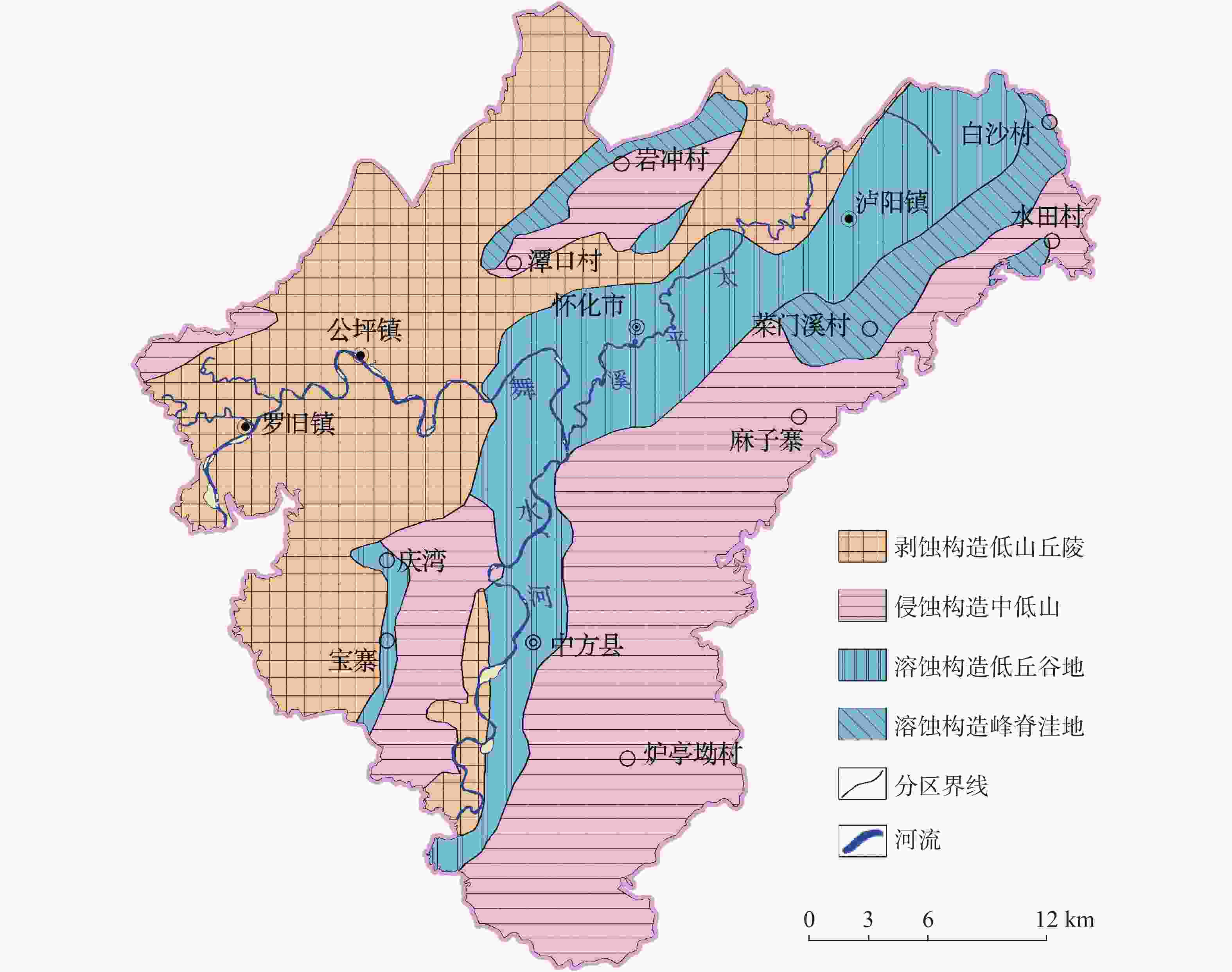
 下载:
下载:
